Your Friday Sound of a Black Hole
Paint My World
We write often on WhatTheyThink about the sign business, often focusing on new technologies for sign manufacturing and printing. In a world of channel letters, electric signs, digital signage, and even wide-format printing, we often forget that for most of history, the majority of signs were hand-painted. Print magazine this week had a feature on John King, who is on a mission to keep alive traditional sign painting. A sign painter and letterer, he (like many people in the sign business) got into it by accident, ending up in a Shepparton, Australia, sign painting shop.
Then 15-year-old King had been pressured by his high school art teacher into doing a two-week long internship at a sign painting business. “He insisted that I do [the apprenticeship program Australia calls] work experience with this guy called Winton Francis, who I had never heard of,” he said. Reluctantly, King obliged. “I remember going there, thinking that it was going to be so boring. For me, a sign was just an entry sign, or parking signs— just boring stuff. That was my view of the signage world.”
Hmm…this might be an interesting approach to Sign Manufacturing Day. We continue.
But the moment he stepped through the doors of Francis’ shop, and thereby into the artistry of sign painting, King was hooked. “I remember walking in and there were air-brushed, chrome Harley Davidson letters on the wall that they were making for a dealer. They had boats and trucks with all of this elaborate scroll work,” he shared. “Winton was a genius. His whole crew worked in this super creative workshop. I spent two weeks there and I was just blown away by the whole thing— watching guys paint these perfectly straight lines with lettering brushes, perfect circles. I didn’t think it was humanly possible.”
He has since dedicated three decades to the art of sign painting. The advent of computers for sign creation in the 1990s led folks like King’s mentor to either adapt or die (Francis refused to use new technologies) and while King still focuses on old-school sign painting, he is no Luddite, sharing his work on Instagram and creating videos to demonstrate his processes.
The launch of Instagram has served as a major catalyst for sign painting’s recent resurgence in popularity, and artists like King are using the platform to honor and spread the old-world handcraft. “It really reignited the flame,” he said. He also gives credit to the 2012 documentary Sign Painters, which heightened the exposure of sign painting and propelled the movement even further. “Those two things happening around the same time as each other really brought sign writing back.”

L’eggo My Logo
As important for brands as logos have become, it was only as recently as the 19th century that the idea of the company or brand logo as we know it was developed, evolving from family coats of arms. If you have an interest in logo design and logo history, we recommend this elaborate book from Taschen: Logo Beginnings.
Author Jens Müller, described as the “logo detective” by Wired magazine, examined historical trademark registers, international corporate archives, and early design publications to unearth more than 6,000 logos from 1870 to 1940. This unparalleled collection traces the development of modern trademarks and sheds light on forgotten designs and early versions of famous logos. The catalog is divided into four design categories: “Figurative,” “Form,” “Effect,” and “Typographical.” Each chapter is then systematically subdivided according to basic elements of design such as circle, line, overlap, and outline, thus offering a new perspective on design principles that are still relevant today.
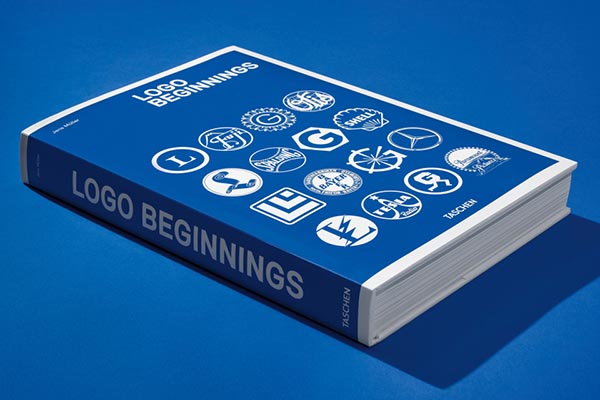
Along with an extensive picture section, the book comprises an introduction by Jens Müller on the history of the trademark as well as a reproduction of the first comprehensive examination of modern corporate logos: the influential design pioneer F.H. Ehmcke’s (1878–1965) illustrated essay “Wahrzeichen—Warenzeichen” (Symbols—trademarks) from 1921. Also included are ten case studies of famous trademarks, including those of 3M, NBC, Shell, and Olivetti, and numerous rare images illustrating the—at times varied, at times consistent—developments in international logo design and the birth of the corporate identity.
It’ll run you $80, but if you’re interested in branding and marketing, it looks like it’s well worth the investment.
Blue Jeans to Dye For
Sure, we all love blue jeans, but after seeing the documentary RiverBlue about the horrible environmental impact of blue jeans production, we wear them not without guilt. However, the movie itself identifies new processes that can make blue jeans more green (figuratively, if not literally). The problem is largely the blue dye. Via The Verge:
denim has a dirty secret: the dye that makes blue jeans so ubiquitous is actually made from fossil fuels and toxic chemicals. For thousands of years, when humans wanted to get a deep blue color, they used natural indigo from Indigofera plants. But in 1897, German chemists started selling a cheaper synthetic version for industrial use. Most pairs of jeans today are dyed with synthetic indigo.
It’s hard to say just how many jeans are made each year, but most estimates are in the billions. To get that blue color, over 70,000 tons of indigo dye are made each year. When the dye (and garment dyes in general) isn’t handled properly, it can end up polluting waterways, damaging local ecosystems, and impacting public health. Luckily, an alternative to synthetic indigo could eventually clean up this step of the manufacturing process.
Now, a California startup is looking to use microbes to create an indigo dye that is less environmentally harmful.
Huue is a startup in Berkeley, California, on a mission to reverse engineer indigo molecules using microbes and sugar. They’re still in the R&D phase, testing out different strains and inputs to achieve a product that could drop into existing production processes. The next challenge is implementing their creation at scale and even expanding to other dyes.
Check out this tour of their lab:
Graphene Goes for the Gold
Was it a good week for graphene news? It’s always a good week for graphene news! Researchers at The University of Manchester, Tsinghua University in China, and the Chinese Academy of Sciences (CAS) have managed to use graphene to extract gold from waste containing only trace amounts of gold—as little as a billionth of a percent. Says Graphene-Info:
This surprising application of graphene was described to work quite straightforwardly: add graphene into a solution containing traces of gold and, after a few minutes, pure gold appears on graphene sheets, with no other chemicals or energy input involved. After this you can extract your pure gold by simply burning the graphene off. The research shows that 1 gram of graphene can be sufficient for extracting nearly 2 grams of gold.
… Gold is used in many industries including consumer electronics (mobile phones, laptops etc.) and, when the products are eventually discarded, little of the electronic waste is recycled. The graphene-based process with its high extraction capacity and high selectivity can reclaim close to 100% of gold from electronic waste. This offers an attractive solution for addressing the gold sustainability problem and e-waste challenges.
The money quote: “Graphene turns rubbish into gold, literally,” added Professor Andre Geim from The University of Manchester.
Tales from the Drought Side
This summer’s record droughts may be terrible for agriculture—or humanity in general—but they are proving a boon for archaeologists across the board. In the province of Caceres, Spain, the Valdecanas reservoir has declined to 28% of capacity and in one corner of it, the remnants of a “Spanish Stonehenge” have emerged. Says Reuters:
Officially known as the Dolmen of Guadalperal but dubbed the Spanish Stonehenge, the circle of dozens of megalithic stones is believed to date back to 5000 BC.
…“It’s a surprise, it’s a rare opportunity to be able to access it,” said archaeologist Enrique Cedillo from Madrid’s Complutense University, one of the experts racing to study the circle before it gets submerged again.
A “dolmen,” by the way, is a type of structure consisting of two or more vertical megaliths supporting a large flat horizontal capstone. They are often believe to be tombs, although despite there being many of them found throughout Europe, no one really knows what they were built for.
Meanwhile, about 1,500 miles west, low water levels in the Danube have revealed dozens of German warships sunk during World War II near Prahovo, Serbia. Again, from Reuters:
The vessels were among hundreds scuttled along the Danube by Nazi Germany's Black Sea fleet in 1944 as they retreated from advancing Soviet forces, and still hamper river traffic during low water levels.
Compounding the problem is that the wrecks still contain ammunition and explosives and pose a hazard to shipping.
“The German flotilla has left behind a big ecological disaster that threatens us, people of Prahovo,” said Velimir Trajilovic, 74, a pensioner from Prahovo who wrote a book about the German ships.
Head back east about 6,000 miles or so, and in Texas, drought conditions in Dinosaur Valley State Park have revealed hitherto unseen dinosaur tracks that date from around 113 million years ago. Says CNN:
“Most tracks that have recently been uncovered and discovered at different parts of the river in the park belong to Acrocanthosaurus. This was a dinosaur that would stand, as an adult, about 15 feet tall and (weigh) close to seven tons,” park spokesperson Stephanie Salinas Garcia told CNN in an email.
The other species that left tracks behind at the park in Glen Rose, Texas, was Sauroposeidon, which would be about 60 feet tall and weigh about 44 tons as an adult, Garcia added.
Head north ~800 miles to where a drying Lake Mead is revealing where people went to sleep with the fishes—even if the fishes aren’t there anymore. From CBS News:
Lake Mead, which can be reached from the Las Vegas Strip by a short ride in the trunk of a car with your hands and feet bound, is drying up in a grueling decades-long drought.
Let’s hope this wasn’t written by CNN’s travel correspondent. We continue.
One particular find caught the attention of mob-watchers: the skeletal remains of a man who had been shot in the head, stuffed in a barrel and tossed in the lake four decades ago.
“The mob had a propensity to put people in barrels, whether they’re burying them in a lake, or dumping them out in the field,” said Geoff Schumacher of The Mob Museum in Las Vegas. “That’s number one. Number two, the person was shot in the head, typical mob hit style. And third, we know that this happened in the late ’70s, early ’80s (when) the mob was very prominent in Las Vegas.”
We are definitely playing hooky from at least a little of PRINTING United to visit The Mob Museum in Vegas.
Now, while all these uncovered relics are fascinating, the one thing that really belongs in bodies of water is, you know, water, and the fact that lakes and rivers seem to have everything but water is more than a little worrying.
Phone it In
Want to design the next iPhone? Play around with options at neal.fun.

There is something perverse about being able to put the android logo on it…
And when you’re done, be sure to accidentally leave a prototype in a San Francisco bar.
Stay Dry
It still occasionally rains, which can be inconvenient for bicyclists and mobility scooter riders, to name two. Now, via Core77, two new design innovations help out both these groups.
First, a bicycle rack designed by veteran industrial designer Gijs Bakker features a flap that keeps the bike’s saddle dry if it is raining out.
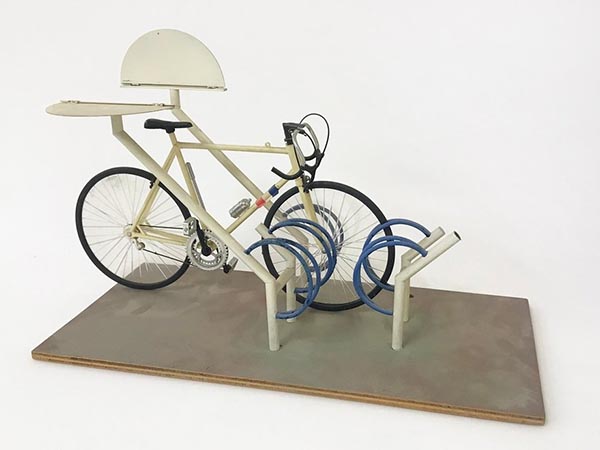
Second, a removable canopy for mobility scooters that keeps riders dry in inclement weather. Created by British industrial design consultancy Nyker Design, the Scooterpac is a folding canopy that can be retrofitted into mobility scooters.

“We aimed to offer a bolt-on solution which can be deployed when needed. This was achieved through a novel multi-stage folding mechanism that can be fixed to any mobility scooter.”
Another option is to park your bike or ride your scooter in many of the world’s major bodies of water. That’ll keep you dry, apparently.
Tilting at Windmills
Gizmodo asks one of those classic philosophical imponderables: “Would You Eat A Windmill?” Surely a question for the ages (and don’t call me Shirley). Well, why would you not? OK, the question is only marginally less silly than it sounds. At issue is what to do with windmills (aka wind turbines) when they reach the end of their useful lives? Eat them? Kind of:
Despite being an excellent source of renewable energy,
And iron!
wind turbines, like most manufactured products, eventually need to be disposed of, for one reason or another. That poses an obviously large problem given their size, but researchers at Michigan State University are working on a novel solution: a newly developed material for making turbines that can be later recycled into everything from car parts to gummy bears.
… Current wind turbine blades can be recycled into other products, such as building materials, but the practice isn’t widespread yet, and these gigantic components instead often just end up in landfills.
So the group developed a new thermoplastic resin comprising glass fibers as well as synthetic and plant-derived polymers. The resin is strong enough for wind turbine blades, but at end of life could be reused for other products such as, say, car parts. But wait! There’s more!
When mixed with minerals, the dissolved turbine blades could be used to produce cultured stone products such as artificial granite countertops, or the recovered material could be crushed and mixed with other resins and used in injection molding machines to create toys or other plastic goods without a drop in the quality of the product.
But keep waiting! There’s even more!
Processing the recovered material in other ways yields even more intriguing recycling possibilities. An alkaline solution can be used to digest the thermoplastic resin to release poly(methyl methacrylate): a clear plastic material often used as a durable alternative to glass. With higher temperatures, we can go one step further to convert the poly(methyl methacrylate) into poly(methacrylic acid): a super-absorbent material used in diapers. A by-product of these recycling processes is potassium lactate, which after beingpurified to the point of being food-grade, was used by the team to create gummy bear candies—which they ate.
Maybe this approach should be taken for other kinds of manufactured items.
Around the Webb Part the Inaugural: To Jupiter and Beyond
NASA’s James Webb Space Telescope* is up and running and brand new images of Jupiter were released this week, capturing details that could give scientists new clues as to what lies below Jupiter’s thick cloud cover.
Says NASA:
In the standalone view of Jupiter, created from a composite of several images from Webb, auroras extend to high altitudes above both the northern and southern poles of Jupiter. The auroras shine in a filter that is mapped to redder colors, which also highlights light reflected from lower clouds and upper hazes. A different filter, mapped to yellows and greens, shows hazes swirling around the northern and southern poles. A third filter, mapped to blues, showcases light that is reflected from a deeper main cloud.
The Great Red Spot, a famous storm so big it could swallow Earth, appears white in these views, as do other clouds, because they are reflecting a lot of sunlight.
“The brightness here indicates high altitude – so the Great Red Spot has high-altitude hazes, as does the equatorial region,” said Heidi Hammel, Webb interdisciplinary scientist for solar system observations and vice president for science at AURA. “The numerous bright white ‘spots’ and ‘streaks’ are likely very high-altitude cloud tops of condensed convective storms.” By contrast, dark ribbons north of the equatorial region have little cloud cover.
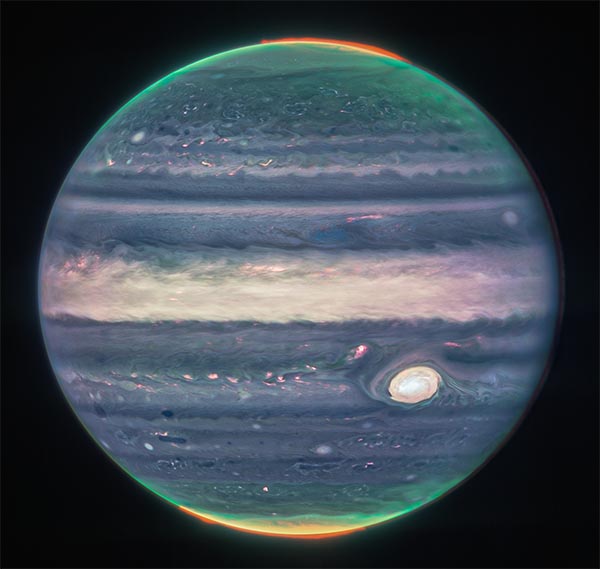
Caption from NASA: Webb NIRCam composite image of Jupiter from three filters – F360M (red), F212N (yellow-green), and F150W2 (cyan) – and alignment due to the planet’s rotation. Credit: NASA, ESA, CSA, Jupiter ERS Team; image processing by Judy Schmidt.
There is also a wider-field image:
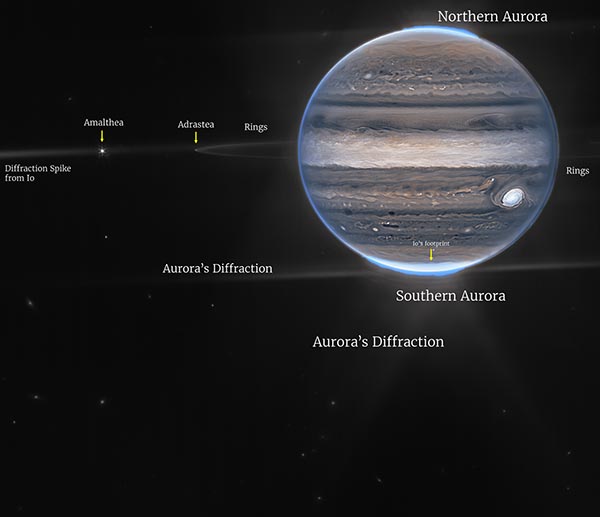
Caption from NASA: Webb NIRCam composite image from two filters – F212N (orange) and F335M (cyan) – of Jupiter system…labeled (bottom). Credit: NASA, ESA, CSA, Jupiter ERS Team; image processing by Ricardo Hueso (UPV/EHU) and Judy Schmidt
In a wide-field view, Webb sees Jupiter with its faint rings, which are a million times fainter than the planet, and two tiny moons called Amalthea and Adrastea. The fuzzy spots in the lower background are likely galaxies “photobombing” this Jovian view.
“This one image sums up the science of our Jupiter system program, which studies the dynamics and chemistry of Jupiter itself, its rings, and its satellite system,” Fouchet said. Researchers have already begun analyzing Webb data to get new science results about our solar system’s largest planet.
The things we can do.
* Not to be confused with the Joe Webb Space Telescope which is used to find declining printing shipments on other worlds.
Mulletzer Prize
What is a Kentucky Waterfall? A Tennessee Top Hat? A Missouri Compromise? Styles of poker? Various 19th-century legislative efforts? Names of thoroughbred race horses? Nope: they are different kinds of mullet. Yes, the hair “style.” (We’d call it more of a hairdon’t than a hairdo.) And believe it or not there are actually awards, bestowed at the USA Mullet Championship, what MPR News calls “a national extravaganza of flamboyant and questionable taste.”
This year’s participants are supporting the full spectrum of the infamous haircut from patriotic vibes, featuring a shorn-in American flag, to the classier Mozart-esque flowing curly locks look.
Contestants pay $10 to enter and CBS reports that “all of the donations are going to the Michigan Wig Foundation for kids.” First place winners each take home a whopping $2,500 prize.
Click through for pictures; don’t if you’re squeamish.
Laser Cat
Over at Laughing Squid, professional cat engineers Paul Kl— Wait…what? Yes: Paul Klusman and TJ Wingard are apparently professional cat engineers (OK, not really), and their latest “Cat Engineer Review” video discusses “the practical utility of equipping cats with laser beams.”
Hot Lips
You may recall that back in June we linked to Velveeta’s new cheese-scented nail polish. Now, also for those who like to besmear themselves with foodstuffs, Applebee’s has teamed with the unfortunately named Winky Lux to come out with Saucy Gloss, a line of lip glosses inspired by chicken wing sauces. There are four flavors:
Get Me Hot Buffalo (“A creamy coral that packs the hot buffalo spice your ex could never have handled”), Sweet Chile Kiss (“A deep rich red kissed with a hint of fine golden Chile specks that put the ‘mmm’ in make out”), Be My Honey Pepper (“A gorgeous, golden honey spiced gloss with shimmering flecks that’ll make you the queen bee of date night”) and Honey BBQ-T (“A shiny, smoky barbecue hue with a side of honey sweetness to make your kisses downright craveable”).
What? No General Tso’s flavor (“Construct China’s first modern naval shipyard on my lips”)?
“Applebee’s is known for first dates and wings – which are one of our most popular menu items,” said Applebee’s Chief Marketing Officer Joel Yashinsky in a statement.
Is it? Is it really? And wouldn’t that be “only date”?
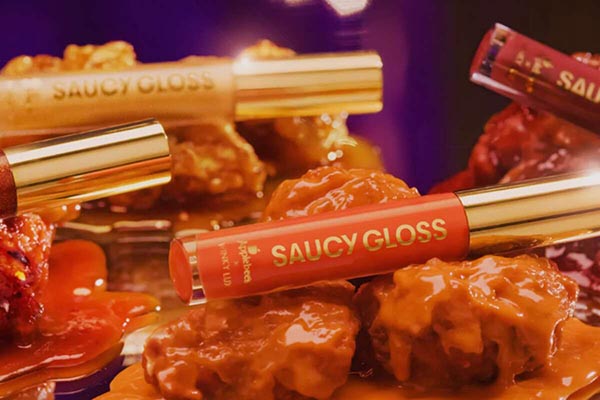
Ah, the things we can do.
This Week in Printing, Publishing, and Media History
August 22
1485: “A horse! My kingdom for a horse!” The Battle of Bosworth Field, the death of Richard III, and the end of the House of Plantagenet.
1849: The first air raid (or perhaps drone strike) in history. Austria launches pilotless balloons against the city of Venice.
1862: French pianist and composer Claude Debussy born.
1893: American poet, short story writer, critic, and satirist Dorothy Parker born.
1902: Theodore Roosevelt becomes the first President of the United States to make a public appearance in an automobile.
1920: American science fiction writer and screenwriter Ray Bradbury born.
1971: American singer-songwriter and guitarist Craig Finn born.
August 23
1946: English drummer, songwriter, and producer Keith Moon born.
1966: Lunar Orbiter 1 takes the first photograph of Earth from orbit around the Moon (not Keith).

1973: A bank robbery gone wrong in Stockholm, Sweden, turns into a hostage crisis; over the next five days the hostages begin to sympathize with their captors, leading to the term “Stockholm syndrome.” (Some trade shows are like that.)
1991: The World Wide Web is opened to the public.
August 24
1456: The printing of the Gutenberg Bible is completed.
1891: Thomas Edison patents the motion picture camera.
1995: Microsoft Windows 95 is released to the public in North America.
1998: First radio-frequency identification (RFID) human implantation is tested in the United Kingdom.
August 25
1609: Galileo Galilei demonstrates his first telescope to Venetian lawmakers.
1835: The first Great Moon Hoax article is published in The New York Sun, announcing the discovery of life and civilization on the Moon. (No one would ever fall for something like that today.)
1867: English physicist and chemist Michael Faraday dies (b. 1791).
1900: German philologist, philosopher, and critic Friedrich Nietzsche dies (b. 1844).
1954: English singer-songwriter, guitarist, and producer Elvis Costello (né Declan MacManus) born.
1991: Linus Torvalds announces the first version of what will become Linux.
2012: Voyager 1 spacecraft enters interstellar space becoming the first man-made object to do so.
August 26
1740: French inventor (hot air balloon) Joseph-Michel Montgolfier born.
1873: American engineer and academic and inventor the Audion tube Lee de Forest born.
1952: American journalist and puzzle creator Will Shortz born.
August 27
1770: German philosopher and academic Georg Wilhelm Friedrich Hegel born.
1871: American novelist and journalist Theodore Dreiser born.
1933: The first Afrikaans Bible is introduced during a Bible Festival in Bloemfontein.
1953: Canadian singer-songwriter, guitarist, and producer Alex Lifeson (né Alexandar Zivojinovich) born.
1971: American publisher, co-founded Random House Bennett Cerf dies (b. 1898).
August 28
1749: German novelist, poet, playwright, and diplomat Johann Wolfgang von Goethe born.
1845: The first issue of Scientific American magazine is published.
1898: Caleb Bradham’s beverage “Brad's Drink” is renamed “Pepsi-Cola.”










Discussion
Join the discussion Sign In or Become a Member, doing so is simple and free